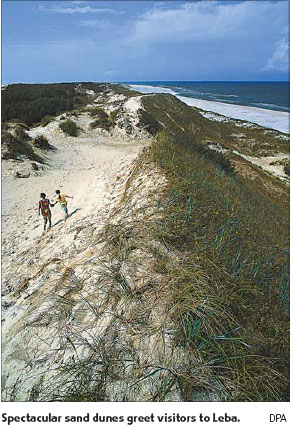Where man and beast are not Poles apart

KOLOBRZEG, Poland: The yellow eyes peer out of the darkness and only hours after enjoying a meal of freshly grilled woodland mushrooms, the holidaymakers find themselves gripped by fear. Man and beast stare at each other for a while until the fox decides the situation is harmless and breaks into a leisurely trot.
Close encounters of this kind are common for vacationers who choose to explore Poland in the spring and late summer months, perhaps by camper van. What they will also find is a calm panorama rare in Europe, and if they care to, they will encounter more animals than human beings.
A few kilometers west of Kolobrzeg, three fishing rods can be seen jutting out of the sand while their owners stare out at the sea in silence. Apart from these stalwarts, there is no one else in sight. Using a portable gas stove, they fry some edible mushrooms bought from an old lady at the roadside.
The Poles love searching for mushrooms and in the autumn hundreds of thousands of them head for the forests in search of the tasty morsels. The boletes, which are easily distinguished from the agarics by color, pores and thick stems and caps, are dried, fried and used mainly for meat dishes or soups. Many are simply sold from roadside booths.
In the morning, the wheels of the camper van are turning again as the travelers head eastwards. There are a host of places for a rest on the way and en route to the Hel peninsula, the coast is lined with wide, deserted beaches and lively resorts. There is something almost unreal about wandering across these expanses of fine sand bordered by lofty dunes.
The contrast between this lonely landscape and the holiday towns of Sarbinowo and Mielno is even more striking. Spartanly-furnished restaurants and garish amusement arcades compete for the attention of the many tourists who come here. Loud merrymaking seems to be going on in even the smallest of villages.
Those in search of peace and quiet are advised to take a room in one of the "Agrotouristik" - farmhouse pensions which tend to be off the beaten track. Camping is also popular and along the coast and inland there are plenty of places to pitch a tent for the night. Many of these sites are privately-run and consist of gardens converted into a place for visitors to sleep and park a car. In many cases, campers take a shower in a converted part of the owner's home.
During their travels, tourists can expect to see plenty of storks - after all, Poland is home to a quarter of the world's stork population. Meanwhile, the bumpy roads are beginning to take their toll on the camper van. The signal on the radio fades in an out.
Soon there are more dunes to be seen on the horizon. They tower above the tops of the trees west of Leba. These sculpted sands were created several thousand years ago after the people who lived here felled trees on a massive scale in order to plant crops.
Strolling through the dunes can be strenuous and it is as well to take along a sufficient supply of water. Clambering up the shimmering white slopes and sliding down them again can be great fun, but it is worth noting that temperatures here can rise quickly to 40 C and more.
The sparsely-populated, hilly landscape known as Pojezierze Kaszubskie or Kashubian Switzerland lies some 50 kilometers south of the city of Gdansk and it features a host of small lakes, extensive forests of beech trees and idyllic valleys.
It is home to the Kaszubskie, an ancient western Slavic ethnic group which has retained a language of its own. The area is easy to explore on foot or by bicycle. One of the best methods is to take the 20-kilometer Kashubian Way, which takes cyclists past half a dozen lakes on its route from Kartuzy to Koscierzyna. The journey through thick forest provides an opportunity for tourists to pick and prepare their own mushroom meal.
After two days of rest, it is time to return to the Hel peninsula, an ideal location for anyone seeking tranquility. The narrow strip of land is perfect for those who can enjoy a holiday without the perfect infrastructure and hotels to match. Like the blade of a scythe, the peninsula stretches out 35 kilometers into the Baltic Ocean. It varies in width from 3 kilometers to 200 meters at its narrowest point. Needless to say, Hel is very popular with surfers.
From Hel it is only 50 kilometers to the historic city of Gdansk, known as the "Queen of the Baltic". It is worth climbing the 400 steps to the top of St. Mary's Church tower to admire a panoramic view of this medieval brick architecture and enchanting houses of this city, many of which were rebuilt after damage during World War II.
Lunch can be taken in one of the many attractive restaurants which serve such local delicacies as Pieroggi, a kind of ravioli, or Barszcz, a vegetable broth with a characteristic strong red color along with various mushroom soups.
DPA
(China Daily 08/16/2007 page19)














